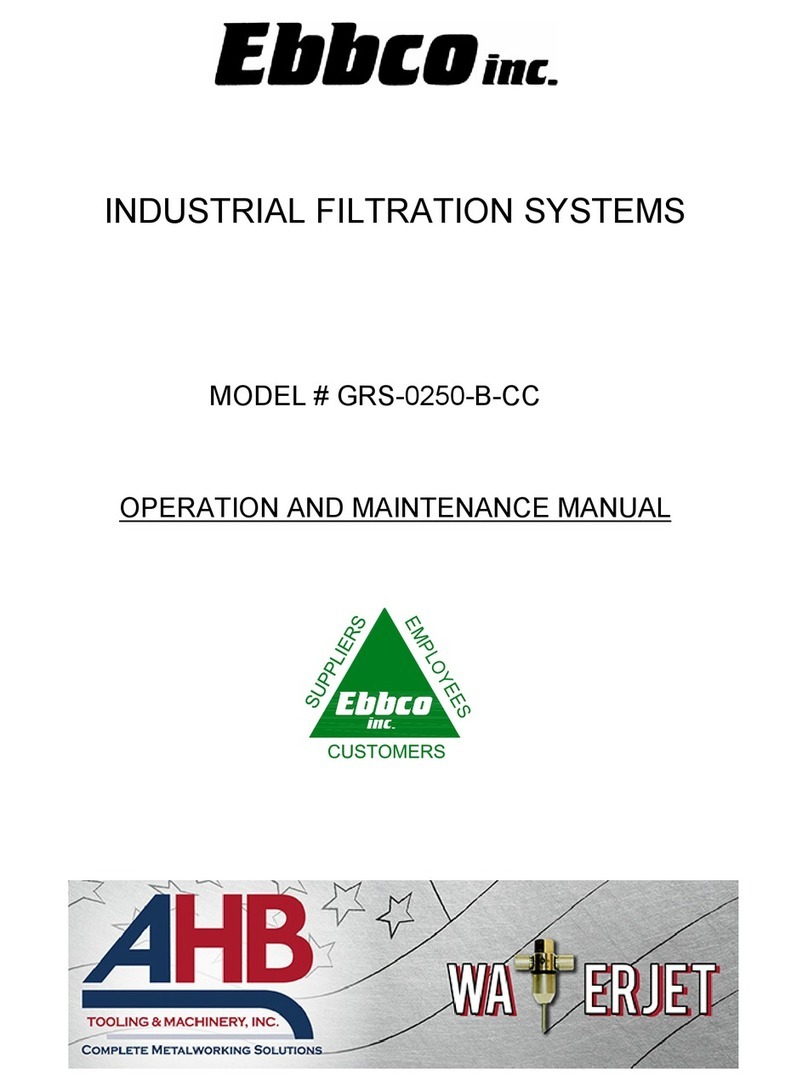
Page | 4
This document is proprietary. No disclosure, reproduction or use of any part thereof may be made without the expressed
written permission of Ebbco Inc. or its subsidiaries.
Section 1: Introduction
1.1 Introduction
This manual provides technical instruction on the installation, and operation of the Closed Loop
Filtration System manufactured by Ebbco Inc. With regular maintenance and proper operation, the Closed
Loop Filtration System will reuse the overflow water from the work tank, and process it so that it meets the
high-pressure pump specifications. The Closed Loop Filtration System will require some on-site
assembly, which includes connecting the Closed Loop Filtration System to the water-jet cutting machines
work tank overflow, connecting the make-up water line, and connecting hoses from the Closed Loop
Filtration to the high-pressure pump. The Closed Loop Filtration System is manufactured using quality
materials by a highly experienced production staff. The Closed Loop Filtration System is tested by Ebbco
Inc. to ensure that it meets all of the specifications required by each customer. The Closed Loop Filtration
System is inspected, and all test data documented prior to shipment.
1.2 Sequence of Operation
The Ebbco Inc. Closed Loop Filtration System (CLS) is designed to allow the user to shut off the
drain and capture overflow water for reuse by polishing it with specialized equipment. The system
operates by using the overflow water from the customer’s waterjet catch tank.
Water from the customer’s waterjet catch tank will overflow into a Settling Weir, preventing any
large solids from entering the Closed Loop System. The Settling Weir will then overflow through the CLS
1.5” system inlet. The water flows through a Pre-Filter Bag on the inside of the CLS 1.5” inlet. This pre-
filter bag will prevent any debris (150 microns and above) from settling into the dirty portion of the system
tank. The dirty tank water level should be consistently around 10 –14”. The float level assembly inside of
the dirty tank will open a valve and supply make-up water if the catch tank overflow supply is insufficient.
From the dirty tank water is pumped, via the system pump, through the bag vessel (vessel # 1).
The water is polished by an ultra-fine bag filter (installed inside of vessel #1) polishing the fluid to 1
micron. Water is then sent through the Hurricane Filter Vessel (vessel #2), where the hurricane filter
cartridge removes particles above 0.35-microns. Water leaves the hurricane vessel as clean fluid and is
deposited into the clean portion of the system tank. The clean tank is constantly monitored by a TDS
(Total Dissolved Solids) Meter to maintain a safe level of D.I. controlled water. Water is directed from the
outlet of the Hurricane Filter Vessel (vessel # 2) into the D.I. Vessel (vessel #3) when the TDS level goes
above the preset high point of the system holding tank. The D.I. vessel is filled with a waterjet resin bag,
which will remove dissolved solids from the water. Water will be reintroduced into the clean tank after
running through the D.I vessel. The High-Pressure Feed Pump delivers the clean, cooled TDS-controlled
water from the clean tank back to the High-Pressure Waterjet Pump. Water will continuously overflow
back into the CLS, continuing the filtration sequence.
The clean tank should always be continuously overflowing into the dirty tank to ensure that there
is always a positive level of clean water for the CLS High-Pressure Feed Pump. This will ensure that there
is always a positive level of clean water for the feed pump to draw from, which will prevent potential
catastrophic feed pump damage or failure. The water that overflows into the dirty tank is again drawn up
and filtered through the aforementioned process.
The CLS is fitted with an Ozone Generator, which will continuously introduce a mixture of ozone
and air into the clean portion of the system tank. This action will help eliminate biological fouling agents in
the entire system. Clean water is routed through a heat exchanger and a closed loop chiller, cooling the
water and removing heat generated by the High-Pressure Cutting Pump, and heat generated by the
cutting process itself.




























